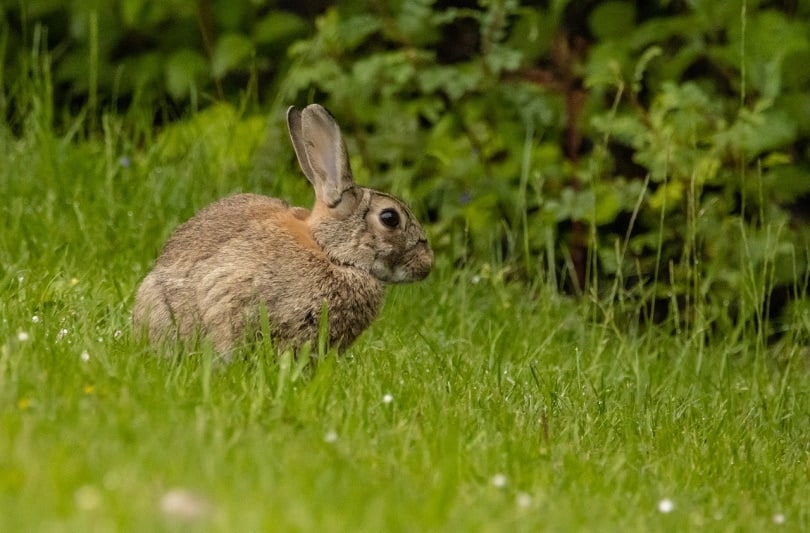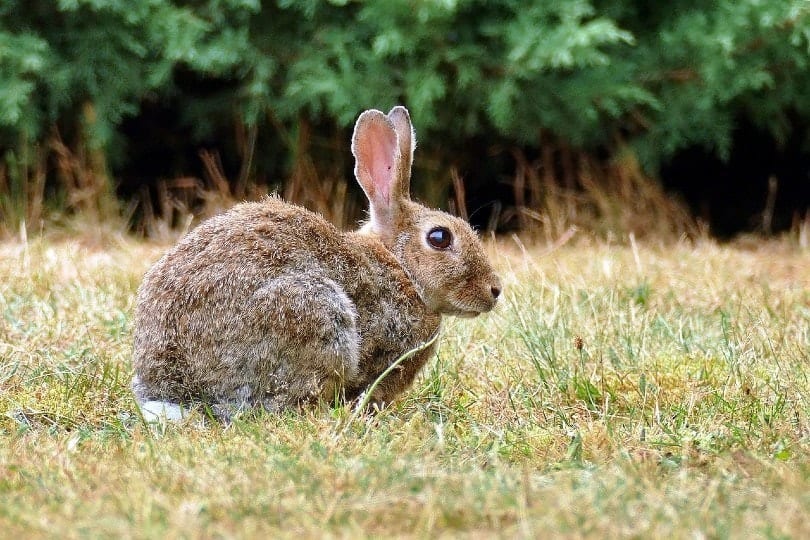The European Hare, also known as the Brown Hare, is one of the largest hares in the world. They are not the same as a domesticated rabbit species, although they are commonly confused as such. Regularly referred to as Jack Rabbits, these hares are shy and high-strung and are generally not kept as pets. They prefer open fields and pastures, foraging mostly at night. These hares are fast runners and have been known to reach speeds of up to 43 mph! Let’s discover the European Hare more in-depth.
| Size: | Large (24–30 inches in length) |
| Weight: | Up to 6–11 pounds |
| Lifespan: | 7–12 years (up to 12 years in the wild) |
| Similar Breeds: | Cape Hare, Corsican Hare, Broom Hare, Granada Hare, Black and White-tailed Jackrabbit, Mountain Hare, Snowshoe Hare, Belgian Hare |
| Suitable for: | Not typically kept as pets |
| Temperament: | High-strung, shy, potentially aggressive |
The European Hare (Lepus europaeus) is naturally distributed in western Europe and Great Britain and is native to continental Europe and the Western and Central parts of Asia. However, humans have introduced them to several continents and other countries, including Canada in the southern Ontario region, as well as the Middle East part of the Asian continent, and the United States.
In the US, they are found in northeastern states and around the Great Lakes. They can also be found in South and Central America. They are related to the Wild-tailed Jack Rabbit, which is also a hare, belonging to the Leporidae family.
European Hare Characteristics
[yasr_multiset setid=7]
Temperament & Intelligence of the European Hare
The European Hare is shy, high-strung, and is not ideal as a pet. They may be aggressive toward other rabbits or hares, and they do not adapt well to human interaction. Even if you happen to run across one and attempt to own one as a pet, the European Hare will never acclimate to domestication.
They are active during dusk and nighttime and hide during the day, known as “form,” which is a depression in the ground. They are built for speed and can run long distances at a time—they will easily become frustrated if they do not have ample room to run, which is what would happen in captivity.
Can European Hares Be Kept as Pets?
Unfortunately, they do not make good pets. Even if you brought one home, you’ll have a wild animal that will be aggressive toward any other pets you may have. It may be possible to own one around a dog or cat, but you’ll need to keep the hare in its own enclosure and away from other pets, as they will, more than likely, be aggressive. These hares are not domesticated and will not adapt to living in captivity well.

Things to Know About the European Hare:
Food & Diet Requirements
European Hares are herbivores, meaning they forage on grass, herbs, soy, clover, corn poppy, and field crops in the spring and summer. In the autumn and winter, they prefer sugar beets, winter wheat, and carrots that are typically provided by hunters, but they’ll also eat twigs, bark of shrubs, buds, and young fruit trees. They will also re-ingest fecal matter to gain maximum nutrients from their food.

Habitat
If kept as a pet, they need large runs because they spend time running large distances, unlike rabbits. They require open habitats and will become agitated if they do not have ample room to run, meaning you’ll need the largest hutch or outdoor enclosure possible. These hares are social in the wild and do not do well being limited to where they can roam. If you happen to rescue a European Hare, it’s best to contact your local rescue area to ensure the hare will have plenty of room to roam like they would in the wild.
Exercise & Sleeping Needs
The European Hare is active during dusk and nighttime and “form” at night—a depression in the ground. They do not create beds or burrows, but the forms allow them to be partially concealed while sleeping.

Appearance
We’ve stated these hares are one of the largest in the world, but what exactly do they look like? The hind legs are strong and average 6 inches long. They have elongated floppy ears with black fur markings at the tips. The fur has a tan, white, and black speck appearance.
Lifespan & Health Conditions
The European Hare is generally healthy, but they are prone to parasites, both internally and externally. Not much is known about the wild European Hare’s health compared to domesticated rabbits, but here’s what we know so far:
Serious Conditions:
European Brown Hare Syndrome (EBHS): A viral infection caused by a calicivirus that can be transmitted directly from hare to hare through ingestion of fecal matter and breathing respiratory droplets. The liver is targeted with this virus with a mortality rate of roughly 2 weeks.
- Canine tapeworms
- Nematodes
- Coccidian
- Liver flukes
Male vs. Female
Males are called bucks, and females are called does. Males are typically smaller than females, and it’s not unusual to see several males fighting for a chance to mate with a female. The female gets chased until she is exhausted, at which time she’ll stop to allow mating, all while the other males continue to fight and attack her.
3 Little-Known Facts About the European Hare
1. They Are Famous for Their “Boxing” Skills
These hares can be seen boxing during mating season, standing on their long and strong hind legs. Boxing usually occurs in females, as they box to fight off males during mating.
2. Their Population Is Declining
Despite having a wide range and a moderately abundant status, their population has been declining since the 1960s in mainland Europe due to hunting, as well as fragmenting from farming.
3. They Have a Specific Eye Structure
Hares can see 360 degrees around them, which allows them to view their environment without moving their heads. They are also born with fur and their eyes open.
Final Thoughts
The European Hare is not a domesticated rabbit. In fact, there are many differences between rabbits and hares—hares are much larger than rabbits, with longer limbs and elongated ears. Hares are also not kept as pets and will not acclimate to life in captivity. They need space to roam freely and forage at night, and they also need room for running large distances at a time. Rabbits make better pets, while hares do better in the wild in their natural habitat.
If you ever run across a baby European Hare and take it home with you, the mother will not accept it back into the wild—it’s best to leave them be unless they are injured, at which point contacting your local rescue will be a better option for care.
Featured Image Credit: pictavio, Pixabay

